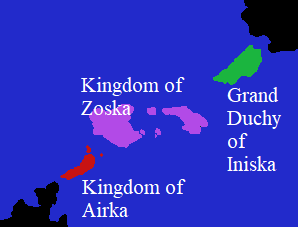Mejika Isles
The Mejika Isles are the bridge between Garadel and Larazel. They are a chain of 15 islands- 4 large and 11 small- that bridge the shallow sea and serve as the primary conduit of trade and movement between the two worlds. They are mercantile centers, of course, but also fraught with religious division and conflict from an old legacy of exploitation.
In the shallow seas surround the Mejika, great and powerful Octoperson polities rule. In times of peace, they are purveyors of trade, but when they fight the resulting disturbance can cause trade issues across the Western Hemisphere.
Geography
There are 15 recognized islands and many tiny islands that make up the Mejika, but the Big Four are those most noteworthy at this time.
The Southernmost island of Airka is also the smallest of the Big Four. It lies 12 miles off the coast of Alaran, and is 96 miles long and 20 miles wide. Small islands surround its coastline. Its eastern coast is swept by soft, cool winds and is semi-arid. It has grassy plains and lightly-distributed vegetation, and has more mild weather. The Western coast is densely forested and more humid, and has more intense weather in the spring and summer.
24 miles from the island periphery of Airka is the largest of the Big Four: Argena. Argena is 130 miles wide and 81 miles long, with a mountainous heartland of dormant volcanoes. It is a rocky, but fertile landscape of lush forests and arable valleys.
6 miles North of Argena is Zoska. Zoska is 87 miles long and 50 miles wide. The most humid and forested of all, Zoska quite abundant in food and freshwater.
85 miles North of Zoska is the most isolated of the four, Iniska. It is 131 miles long and 51 miles wide. Iniska is isolated both by its distance from the others and its tumultuous currents, which sweep around the island in a grand circle. Its West is typically semi-arid chaparral, but is pummeled by periodic monsoon deluges; the East is typically quite forested, but can have droughts while the other have pours. Iniska is 14 miles from Vizukel, the coast of continental Larazel.
Fauna & Flora
The Mejika once had unique fauna- giant tortoises and unusual white-and-black foxes, the records say. Birds of unusual color and call for every island. But few remain of them, after so many centuries of hunters, pillagers, and invasive species.
Most notable of what remains are the coral reefs, which thrive in the shallow sea surrounding the Mejika.
History
Early Land History
The Seas Boil
Modern History
Type
Archipelago
Location under
Included Organizations
Related Plots
Remove these ads. Join the Worldbuilders Guild






Comments